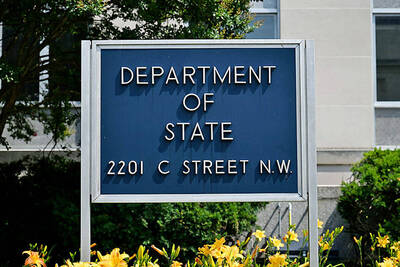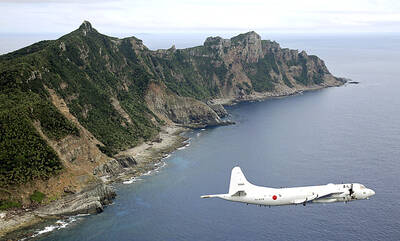Japan’s nuclear crisis intensified yesterday as authorities raced to combat the threat of multiple reactor meltdowns and more than 170,000 people evacuated the quake and tsunami-savaged northeastern coast where fears spread over possible radioactive contamination.
Nuclear plant operators were frantically trying to keep temperatures down in a series of nuclear reactors — including one where officials feared a partial meltdown could be happening yesterday — to prevent the situation from deteriorating.
Japanese Chief Cabinet Secretary Yukio Edano said yesterday that a hydrogen explosion could occur at Unit 3 of the Fukushima Dai-ichi nuclear complex, the latest reactor to face a possible meltdown.

Photo: Reuters
That follows a blast the day before in the power plant’s Unit 1.
“At the risk of raising further public concern, we cannot rule out the possibility of an explosion,” Edano said. “If there is an explosion, however, there would be no significant impact on human health.”
Edano said the radioactivity released into the environment so far was so small it posed no health threat.
He said none of the Fukushima Dai-ichi reactors was near the point of complete meltdown and he was confident of escaping the worst scenarios.
A complete meltdown — the collapse of a power plant’s ability to keep temperatures under control — could release uranium and dangerous contaminants into the environment and pose major, widespread health risks.
WAITING
Up to 160 people, including 60 elderly patients and medical staff who had been waiting for evacuation in the nearby town of Futabe, and 100 others evacuating by bus, might have been exposed to radiation, said Ryo Miyake, a spokesman from Japan’s nuclear agency.
The severity of their exposure, or if it had reached dangerous levels, was not clear. They were being taken to hospitals.
Edano said operators were trying to cool and decrease the pressure in the Unit 3 reactor, just as they had the day before at Unit 1.
Japan struggled with the nuclear crisis as it tried to determine the scale of the Friday disasters, when the most powerful quake in the country’s recorded history was followed by a tsunami.
More than 1,400 people were killed and hundreds more were missing, according to officials, but police in one of the worst-hit areas estimated the toll there alone could eventually top 10,000.
The scale of the disasters seemed to be outpacing the efforts of Japanese authorities to bring the situation under control.
Rescue teams were struggling to search hundreds of kilometers of devastated coastline and hundreds of thousands of hungry survivors huddled in darkened emergency centers cut off from rescuers and aid. At least 1.4 million households had gone without water since the quake, and food and gasoline were quickly running out across the region. Large areas of the countryside were surrounded by water and unreachable. About 2 million households were without electricity.
POWER OUTAGE
Unit 3 at the Fukushima plant is one of three reactors there that had automatically shut down and lost cooling functions necessary to keep fuel rods working properly because of a power outage from the quake. The facility’s Unit 1 is also in trouble, but Unit 2 is less affected.
On Saturday, an explosion destroyed the walls of Unit 1 as operators tried to prevent it from overheating and melting down.
Without power and with its valves and pumps damaged by the tsunami, authorities resorted to drawing sea water mixed with boron in an attempt to cool the unit’s overheated uranium fuel rods. Boron disrupts nuclear chain reactions.
The move likely renders the 40-year-old reactor unusable, said a foreign ministry official briefing reporters. Officials said the sea water will remain inside the unit, possibly for several months.
Robert Alvarez, senior scholar at the Institute for Policy Studies and former senior policy adviser to the US secretary of energy, told reporters that the sea water was a desperate measure.
“It’s a Hail Mary pass,” he said.
He said that the success of using sea water and boron to cool the reactor will depend on the volume and rate of their distribution.
Another key, he said, was the restoration of electrical power, so that normal cooling systems can operate.
Edano said the cooling operation at Unit 1 was going smoothly after the sea water was pumped in.
Operators released slightly radioactive air from Unit 3 yesterday, while injecting water into it hoping to reduce pressure and temperature to prevent a possible meltdown, Edano said.
He said radiation levels just outside the plant briefly rose above legal limits, but since had declined significantly. Also, fuel rods were exposed briefly, he said, indicating that coolant water didn’t cover the rods for some time. That would have contributed further to raising the temperature in the reactor vessel.
At an evacuation center in Koriyama, about 60km from the troubled reactors and 190km north of Tokyo, medical experts had checked about 1,500 people for radiation exposure in an emergency testing center, an official said.
steady flow
Yesterday, a steady flow of people arrived at the center, where they were checked by officials.
Officials placed five reactors, including Units 1 and 3 at Dai-ichi, under states of emergency on Friday after operators lost the ability to cool the reactors using usual procedures.
An additional reactor was added to the list early yesterday, for a total of six — three at the Dai-ichi complex and three at another nearby complex. Local evacuations have been ordered at each location. Japan has 55 reactors spread across 17 complexes nationwide.
Officials began venting radioactive steam at Fukushima Dai-ichi’s Unit 1 to relieve pressure inside the reactor vessel, which houses the overheated uranium fuel.
Concerns escalated dramatically on Saturday when that unit’s containment building exploded.
Officials were aware that the steam contained hydrogen and were risking an explosion by venting it, acknowledged Shinji Kinjo, spokesman for the government’s Nuclear and Industrial Safety Agency, but chose to do so because they needed to keep circulating cool water on the fuel rods to prevent a meltdown.
Officials insisted there was no significant radioactive leak after the explosion.

MISINFORMATION: The generated content tends to adopt China’s official stance, such as ‘Taiwan is currently governed by the Chinese central government,’ the NSB said Five China-developed artificial intelligence (AI) language models exhibit cybersecurity risks and content biases, an inspection conducted by the National Security Bureau (NSB) showed. The five AI tools are: DeepSeek, Doubao (豆包), Yiyan (文心一言), Tongyi (通義千問) and Yuanbao (騰訊元寶), the bureau said, advising people to remain vigilant to protect personal data privacy and corporate business secrets. The NSB said it, in accordance with the National Intelligence Services Act (國家情報工作法), has reviewed international cybersecurity reports and intelligence, and coordinated with the Ministry of Justice Investigation Bureau and the National Police Agency’s Criminal Investigation Bureau to conduct an inspection of China-made AI language

BOOST IN CONFIDENCE: The sale sends a clear message of support for Taiwan and dispels rumors that US President Donald Trump ‘sold out’ the nation, an expert said The US government on Thursday announced a possible sale to Taiwan of fighter jet parts, which was estimated to cost about US$330 million, in a move that an expert said “sends a clear message of support for Taiwan” amid fears that Washington might be wavering in its attitude toward Taipei. It was the first announcement of an arms sale to Taiwan since US President Donald Trump returned to the White House earlier this year. The proposed package includes non-standard components, spare and repair parts, consumables and accessories, as well repair and return support for the F-16, C-130 and Indigenous Defense Fighter aircraft,

CHECKING BOUNDARIES: China wants to disrupt solidarity among democracies and test their red lines, but it is instead pushing nations to become more united, an expert said The US Department of State on Friday expressed deep concern over a Chinese public security agency’s investigation into Legislator Puma Shen (沈伯洋) for “secession.” “China’s actions threaten free speech and erode norms that have underpinned the cross-strait ‘status quo’ for decades,” a US Department of State spokesperson said. The Chongqing Municipal Public Security Bureau late last month listed Shen as “wanted” and launched an investigation into alleged “secession-related” criminal activities, including his founding of the Kuma Academy, a civil defense organization that prepares people for an invasion by China. The spokesperson said that the US was “deeply concerned” about the bureau investigating Shen

DISPUTE: A Chinese official prompted a formal protest from Tokyo by saying that ‘the dirty head that sticks itself out must be cut off,’ after Takaichi’s Taiwan remarks Four armed China Coast Guard vessels yesterday morning sailed through disputed waters controlled by Japan, amid a diplomatic spat following Japanese Prime Minister Sanae Takaichi’s comments on Taiwan. The four ships sailed around the Senkaku Islands — known as the Diaoyutai Islands (釣魚台) to Taiwan, and which Taiwan and China also claim — on Saturday before entering Japanese waters yesterday and left, the Japan Coast Guard said. The China Coast Guard said in a statement that it carried out a “rights enforcement patrol” through the waters and that it was a lawful operation. As of the end of last month,